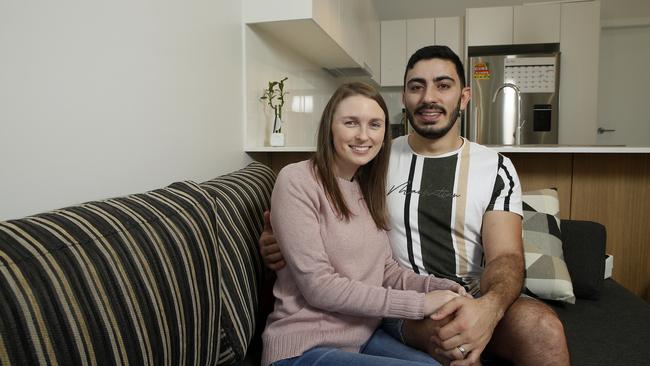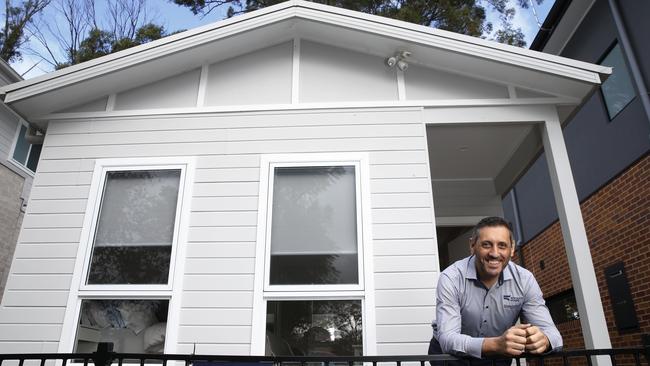‘This is it’: model to help solve housing crisis
Experts are claiming this versatile approach, that appeals to a broad range of homeseekers could help to alleviate our housing crisis.

Property
Don't miss out on the headlines from Property. Followed categories will be added to My News.
As 20-something newlyweds trying to save for their first home, paying rent in an area of Sydney they wanted to live was a daunting prospect for Anthony and Brittany Caiger.
With rental rates skyrocketing over the past few years, the couple instead opted to move into a granny flat in the backyard of Anthony’s parents’ home on the north shore so they could put aside money for a deposit for a mortgage.
Forgoing the luxury of space, the pair lived in the granny flat for a year and a half before buying their own home nearby.
“We couldn’t afford to rent on the north shore or the east side of Sydney – we would have had to move out to western Sydney, but my wife works in the city as an events manager and I work in the area, so it wasn’t feasible for us,” Anthony, a 30-year-old project manager says.
Having realised the benefits a granny flat offers, the couple decided to build one of their own as an investment.

“Once you own a property, putting a granny flat on it is a no-brainer if you have the land for it,” Anthony says.
“If you can spend $150,000 on a granny flat and get $600 a week rent it pays itself off very quickly. We should be able to pay it off in the next six years, then have a second dwelling on the property that’s making extra money.”
The self-contained accommodation has two bedrooms, one bathroom and a separate laundry.
“Everything’s new,” Anthony says. “It’s nicer than the house we live in. We considered moving in and renting our house out instead.”
Builders began work in December and, with a break over the Christmas period, it was finished in about four months.
The couple had planned to rent it out through a real estate agency, but their friend, Rhod-Lee Mercado, got in touch to say the lease on the unit he was renting in Parramatta was expiring and ask if he could move in.
Down the track, the Caigers have thought about renting it out to a single parent, and one day moving their grandparents into the space so they can help look after them.
“Both of our families have looked after us a lot before and after we got married, so it’s a small way of being able to pay them back if they need someone to care for them,” Anthony says.
Long-term, it could be somewhere their unborn children could live.
The median rent in Sydney was $440 in April – up 9 per cent on the same time the previous year, according to property data company CoreLogic.

“By the time we have kids and they grow up, I can only imagine the market is going to be many times worse, so we’re planning for that down the track,” Anthony says. “If we’re still at the same property in 20 years’ time it’s somewhere our kids could potentially move out to.”
If more people follow the same thought pattern, Anthony believes it could ease the housing crisis Sydney is facing.
“The sort of people who need easier access to housing are the sort of people who can afford a granny flat,” he says.
“A granny flat is all a young couple needs when they’re first married. I think it’s a good stepping stone to saving up for a property.”
A report by Archistar, Blackfort and CoreLogic finds 17.6 per cent of all Sydney metro properties have the potential to house a granny flat.
“The cost of building or buying a home is becoming unattainable for people,” says Wally Gebrael, who is director and design manager at Waitara-based Granny Flat Solutions. “A lot of people are seeing this as an opportunity to put family in it or rent it out and gain an income.
“The notion of owning them as an investment has grown substantially. People investing between $150,000 and $200,000 are getting a decent return.
“There are also a lot of downsizers who don’t need a family home anymore. Grandparents are more than happy to live in a small apartment in the backyard so they’re still close by.”
Granny Flat Solutions began operating in 2011, building eight granny flats in its first year.
“I thought it was a great opportunity for affordable housing, even back then, but people didn’t quite understand the benefits,” Gebrael says.

“They weren’t your shabby little garage conversion – they were small homes.”
These days, the company builds between 200 and 250 granny flats a year throughout Sydney, The Central Coast and Newcastle.
“When Covid hit and the cost of construction started to increase people began to move away from building new homes, but we’ve seen a huge trend towards people building granny flats instead of homes,” Gebrael says. “I put it down to cost-of-living pressures. People can live in their house while they build their granny flat, then move into it and rent out their house, or rent out the granny flat.”
To build a granny flat, properties need to have a minimum land size of 450sq m and 12m frontage. They typically have two bedrooms, and can be up to 60sq m in suburban areas and 120 sqm in rural areas.
“We have built some with three bedrooms but they’re more for owner-occupiers,” Gebrael says. “With owner-occupiers, we have seen a lot of people ask for one big bedroom and a small one, which acts as a home office, storage room or study, and some people have asked for a walk-in robe. These are modern homes – they’re just on a smaller scale.

“I don’t think we have ever really built two the same. Some people have asked for a bigger kitchen to fit a 900mm-wide oven. That makes it interesting for us as well so we’re not selling the same product over and over again.”
Gebrael estimates about 60 per cent of people who build granny flats are investors and 40 per cent are “owner-occupiers” who want to house their elderly parents or children. And he agrees it could help provide a fast solution to the housing crisis.
“You can get a granny flat designed, approved and built in under six months,” he says.
Alan Hashem, who is head of user experience at Woolloomooloo-based BuildM, says modular granny flats can have an even faster turnaround.
His company’s offerings are built in a warehouse in Penrith and lifted into the homeowner’s backyard via crane.
“Weather conditions don’t play a factor because it’s undercover and they’re usually built in three months so there’s not that much time for the price of building materials to fluctuate,” he says.

The prefabricated homes cost from $90,000, including installation.
“Some people don’t want something forever,” Hashem says. “For example, some people may have elderly parents and they might want them to move into it for eight to 10 years. It gives people that flexibility.”
While during Covid most clients were people who wanted to house their elderly parents, the company is now getting more interest from mum and dad investors.
“People are saying they need extra income because they can’t handle 13 interest rate rises and they have overcapitalised on their property,” Hashem says.
“We’re seeing a huge demand from everyone trying to assist with the housing crisis that we’re currently facing. Real estate agents are saying they used to have four inquiries at an inspection and now they’re getting 20 to 30 people show up – we have a big shortage at the moment. If you’re looking at what model is going to help solve this crisis, this is it.”




